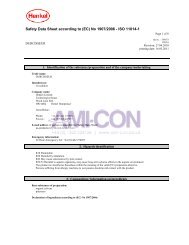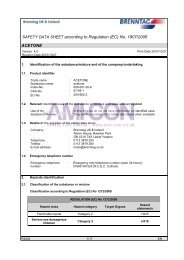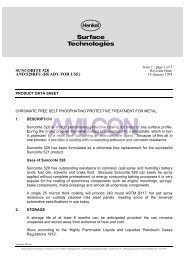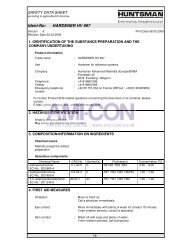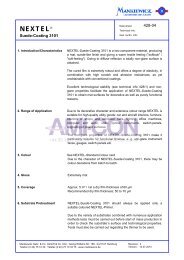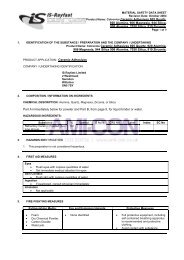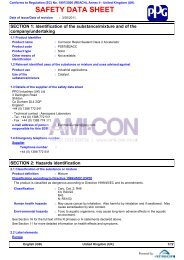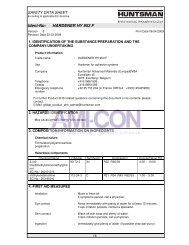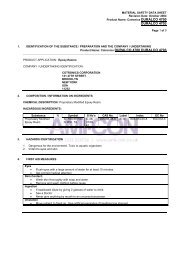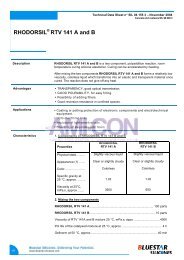Safety Data Sheet according to (EC) No 1907/2006 - AMI-CON
Safety Data Sheet according to (EC) No 1907/2006 - AMI-CON
Safety Data Sheet according to (EC) No 1907/2006 - AMI-CON
You also want an ePaper? Increase the reach of your titles
YUMPU automatically turns print PDFs into web optimized ePapers that Google loves.
<strong>Safety</strong> <strong>Data</strong> <strong>Sheet</strong> <strong>according</strong> <strong>to</strong> (<strong>EC</strong>) <strong>No</strong> <strong>1907</strong>/<strong>2006</strong>CATALYST 9 AMB 4 OZ SP<strong>EC</strong>Page 1 of 9sds no. : 328806V003.1Revision: 30.05.2011printing date: 08.11.2011S<strong>EC</strong>TION 1: Identification of the substance/mixture and of the company/undertakingProduct identifier:CATALYST 9 AMB 4 OZ SP<strong>EC</strong>Contains:3,6,9-Triazaundecamethylenediamine CAS-<strong>No</strong>. 112-57-2Relevant identified uses of the substance or mixture and uses advised against:Intended use:HardenerDetails of the supplier of the safety data sheet:Henkel Limited2 Bishop Square Business ParkAL109EY Herfordshire HatfieldGreat BritainPhone: +44 1606 593933Fax-no.: +44 1606 863762ua-productsafety.uk@uk.henkel.comEmergency telephone number:24 Hours Emergency Tel: +44(0)8701906777Classification of the substance or mixture:S<strong>EC</strong>TION 2: Hazards identificationClassification (CLP):Acute <strong>to</strong>xicity Category 4H302 Harmful if swallowed.Acute <strong>to</strong>xicity Category 4H312 Harmful in contact with skin.Chronic hazards <strong>to</strong> the aquatic environment Category 2H411 Toxic <strong>to</strong> aquatic life with long lasting effects.Skin corrosionCategory 1BH314 Causes severe skin burns and eye damage.Skin sensitizer Category 1H317 May cause an allergic skin reaction.
MSDS-<strong>No</strong>.: 328806V003.1CATALYST 9 AMB 4 OZ SP<strong>EC</strong> Page 2 of 9Classification (DPD):C - CorrosiveR34 Causes burns.Xn - HarmfulR21/22 Harmful in contact with skin and if swallowed.N - Dangerous for theenvironmentR51/53 Toxic <strong>to</strong> aquatic organisms, may cause long-term adverse effects in the aquatic environment.SensitizingR43 May cause sensitisation by skin contact.Label elements (CLP):Hazard pic<strong>to</strong>gram:Signal word:Hazard statement:Precautionary statement:DangerH312 Harmful in contact with skin.H302 Harmful if swallowed.H314 Causes severe skin burns and eye damage.H317 May cause an allergic skin reaction.H411 Toxic <strong>to</strong> aquatic life with long lasting effects.P305+P351+P338 IF IN EYES: Rinse cautiously with water for several minutes. Removecontact lenses, if present and easy <strong>to</strong> remove. Continue rinsing.P313 Get medical advice/attention.P302+P352 IF ON SKIN: Wash with plenty of soap and water.P101 If medical advice is needed, have product container or label at hand.P280 Wear protective gloves/protective clothing/eye protection/face protection.P273 Avoid release <strong>to</strong> the environment.Other hazards:<strong>No</strong>ne if used properly.General chemical description:HardenerBase substances of preparation:organic amineS<strong>EC</strong>TION 3: Composition/information on ingredientsDeclaration of the ingredients <strong>according</strong> <strong>to</strong> CLP (<strong>EC</strong>) <strong>No</strong> 1272/2008:Hazardous componentsCAS-<strong>No</strong>.3,6,9-Triazaundecamethylenediamine112-57-2<strong>EC</strong> NumberREACH-Reg <strong>No</strong>.contentClassification203-986-2 80- 100 % Acute <strong>to</strong>xicity 4; OralH302Acute <strong>to</strong>xicity 4; DermalH312Chronic hazards <strong>to</strong> the aquatic environment 2H411Skin corrosion 1BH314Skin sensitizer 1H317Only dangerous ingredients for which a CLP classification is already available are displayed in this table.For full text of the H - statements and other abbreviations see section 16 "Other information".Substances without classification may have community workplace exposure limits available.
MSDS-<strong>No</strong>.: 328806V003.1CATALYST 9 AMB 4 OZ SP<strong>EC</strong> Page 3 of 9Declaration of ingredients <strong>according</strong> <strong>to</strong> DPD (<strong>EC</strong>) <strong>No</strong> 1999/45:Hazardous componentsCAS-<strong>No</strong>.3,6,9-Triazaundecamethylenediamine112-57-2<strong>EC</strong> NumberREACH-Reg <strong>No</strong>.contentClassification203-986-2 80 - 100 % Xn - Harmful; R21/22R43C - Corrosive; R34N - Dangerous for theenvironment; R51, R53For full text of the R-Phrases indicated by codes see section 16 'Other Information'.Substances without classification may have community workplace exposure limits available.Description of first aid measures:S<strong>EC</strong>TION 4: First aid measuresInhalation:Move <strong>to</strong> fresh air. If symp<strong>to</strong>ms persist, seek medical advice.Skin contact:Immediately remove soiled or soaked clothing.Rinse with running water and soap.Seek medical advice.Eye contact:Rinse immediately with plenty of running water (for 10 minutes), seek medical attention from a specialist.Ingestion:Rinse mouth, drink 1-2 glasses of water, do not induce vomiting, consult a doc<strong>to</strong>r.Most important symp<strong>to</strong>ms and effects, both acute and delayed:SKIN: Redness, inflammation.INGESTION: Nausea, vomiting, diarrhoea, abdominal pain.SKIN: Rash, Urticaria.Causes burns.Indication of any immediate medical attention and special treatment needed:See section: Description of first aid measuresExtinguishing media:Suitable extinguishing media:water, carbon dioxide, foam, powderS<strong>EC</strong>TION 5: Firefighting measuresExtinguishing media which must not be used for safety reasons:High pressure waterjetSpecial hazards arising from the substance or mixture:In the event of a fire, carbon monoxide (CO) and carbon dioxide (CO2) can be released.In case of fire, keep containers cool with water spray.Advice for firefighters:Wear self-contained breathing apparatus and full protective clothing, such as turn-out gear.S<strong>EC</strong>TION 6: Accidental release measures
MSDS-<strong>No</strong>.: 328806V003.1CATALYST 9 AMB 4 OZ SP<strong>EC</strong> Page 4 of 9Personal precautions, protective equipment and emergency procedures:Avoid contact with skin and eyes.Wear protective equipment.Environmental precautions:Do not empty in<strong>to</strong> drains / surface water / ground water.Methods and material for containment and cleaning up:For small spills wipe up with paper <strong>to</strong>wel and place in container for disposal.For large spills absorb on<strong>to</strong> inert absorbent material and place in sealed container for disposal.Reference <strong>to</strong> other sections:See advice in chapter 8Precautions for safe handling:Avoid skin and eye contact.See advice in chapter 8Hygiene measures:Good industrial hygiene practices should be observed.S<strong>EC</strong>TION 7: Handling and s<strong>to</strong>rageConditions for safe s<strong>to</strong>rage, including any incompatibilities:Ensure good ventilation/extraction.Keep container tightly sealed.S<strong>to</strong>re at room temperature.Specific end use(s):HardenerS<strong>EC</strong>TION 8: Exposure controls/personal protectionControl parameters:Valid forGreat Britain<strong>No</strong>neExposure controls:Engineering controls:Ensure good ventilation/extraction.Respira<strong>to</strong>ry protection:Ensure adequate ventilation.An approved mask or respira<strong>to</strong>r fitted with an organic vapour cartridge should be worn if the product is used in a poorlyventilated areaFilter type: AHand protection:Chemical-resistant protective gloves (EN 374).Suitable materials for short-term contact or splashes (recommended: at least protection index 2, corresponding <strong>to</strong> > 30minutes permeation time as per EN 374):nitrile rubber (NBR; >= 0.4 mm thickness)Suitable materials for longer, direct contact (recommended: protection index 6, corresponding <strong>to</strong> > 480 minutes permeationtime as per EN 374):nitrile rubber (NBR; >= 0.4 mm thickness)This information is based on literature references and on information provided by glove manufacturers, or is derived byanalogy with similar substances. Please note that in practice the working life of chemical-resistant protective gloves may beconsiderably shorter than the permeation time determined in accordance with EN 374 as a result of the many influencingfac<strong>to</strong>rs (e.g. temperature). If signs of wear and tear are noticed then the gloves should be replaced.
MSDS-<strong>No</strong>.: 328806V003.1CATALYST 9 AMB 4 OZ SP<strong>EC</strong> Page 5 of 9Eye protection:<strong>Safety</strong> glasses with sideshields or chemical safety goggles should be worn if there is a risk of splashing.Skin protection:Wear suitable protective clothing.S<strong>EC</strong>TION 9: Physical and chemical propertiesInformation on basic physical and chemical properties:AppearanceliquidliquidAmberOdorAminepHInitial boiling pointFlash pointDecomposition temperatureVapour pressureDensity()Bulk densityViscosityViscosity (kinematic)Explosive propertiesSolubility (qualitative)(Solvent: Water)Solidification temperatureMelting pointFlammabilityAu<strong>to</strong>-ignition temperatureExplosive limitsPartition coefficient: n-octanol/waterEvaporation rateVapor densityOxidising propertiesnot applicable320 °C (608 °F)170 °C (338 °F)<strong>No</strong> data available / <strong>No</strong>t applicable< 0,1 mm hg0,99 g/cm3<strong>No</strong> data available / <strong>No</strong>t applicable<strong>No</strong> data available / <strong>No</strong>t applicable<strong>No</strong> data available / <strong>No</strong>t applicable<strong>No</strong> data available / <strong>No</strong>t applicableSoluble<strong>No</strong> data available / <strong>No</strong>t applicable<strong>No</strong> data available / <strong>No</strong>t applicable<strong>No</strong> data available / <strong>No</strong>t applicable<strong>No</strong> data available / <strong>No</strong>t applicable<strong>No</strong> data available / <strong>No</strong>t applicable<strong>No</strong> data available / <strong>No</strong>t applicable<strong>No</strong> data available / <strong>No</strong>t applicable<strong>No</strong> data available / <strong>No</strong>t applicable<strong>No</strong> data available / <strong>No</strong>t applicableOther information:Ignition temperature321 °C (609.8 °F)S<strong>EC</strong>TION 10: Stability and reactivityReactivity:Strong oxidizing agents.Acids.Chemical stability:Stable under recommended s<strong>to</strong>rage conditions.Possibility of hazardous reactions:See section reactivityConditions <strong>to</strong> avoid:<strong>No</strong> decomposition if s<strong>to</strong>red and applied as directed.Incompatible materials:<strong>No</strong>ne if used properly.Hazardous decomposition products:Hydrocarbonscarbon oxides.nitrogen oxidesRapid polymerisation may generate excessive heat and pressure.
MSDS-<strong>No</strong>.: 328806V003.1CATALYST 9 AMB 4 OZ SP<strong>EC</strong> Page 6 of 9S<strong>EC</strong>TION 11: Toxicological informationGeneral <strong>to</strong>xicological information:The mixture is classified based on the available hazard information for the ingredients as defined in the classification criteriafor mixtures for each hazard class or differentiation in Annex I <strong>to</strong> Regulation 1272/2008/<strong>EC</strong>. Relevant availablehealth/ecological information for the substances listed under Section 3 is provided in the following.Oral <strong>to</strong>xicity:Harmful if swallowed.Dermal <strong>to</strong>xicity:Harmful in contact with skin.Skin irritation:CorrosiveCauses burns.Eye irritation:CorrosiveRisk of serious damage <strong>to</strong> eyesSensitizing:May cause sensitization by skin contact.S<strong>EC</strong>TION 12: Ecological informationGeneral ecological information:The mixture is classified based on the available hazard information for the ingredients as defined in the classification criteriafor mixtures for each hazard class or differentiation in Annex I <strong>to</strong> Regulation 1272/2008/<strong>EC</strong>. Relevant availablehealth/ecological information for the substances listed under Section 3 is provided in the following.Eco<strong>to</strong>xicity:Toxic <strong>to</strong> aquatic organismsMay cause long-term adverse effects in the aquatic environment.Mobility:Cured adhesives are immobile.Persistence and Biodegradability:The product is not biodegradable.Toxicity:Hazardous componentsCAS-<strong>No</strong>.3,6,9-Triazaundecamethylenediamine112-57-23,6,9-Triazaundecamethylenediamine112-57-23,6,9-Triazaundecamethylenediamine112-57-2ValuetypeValueAcuteToxicityStudyExposuretimeSpeciesMethodLC50 420 mg/l Fish 96 h Poecilia reticulata O<strong>EC</strong>D Guideline203 (Fish, AcuteToxicity Test)<strong>EC</strong>50 24,1 mg/l Daphnia 48 h Daphnia magna O<strong>EC</strong>D Guideline202 (Daphnia sp.AcuteImmobilisationTest)<strong>EC</strong>50 6,8 mg/l Algae 72 h Selenastrum capricornutum(new name: Pseudokirchnerellasubcapitata)O<strong>EC</strong>D Guideline201 (Alga, GrowthInhibition Test)Persistence and degradability:Hazardous componentsCAS-<strong>No</strong>.ResultRoute ofapplicationDegradabilityMethod
MSDS-<strong>No</strong>.: 328806V003.1CATALYST 9 AMB 4 OZ SP<strong>EC</strong> Page 7 of 93,6,9-Triazaundecamethylenediamine112-57-2under test conditions nobiodegradation observedaerobic 0 % O<strong>EC</strong>D Guideline 301 D (ReadyBiodegradability: Closed BottleTest)Bioaccumulative potential / Mobility in soil:Hazardous componentsCAS-<strong>No</strong>.3,6,9-Triazaundecamethylenediamine112-57-2LogKow Bioconcentrationfac<strong>to</strong>r (BCF)-3,16ExposuretimeSpecies Temperature MethodS<strong>EC</strong>TION 13: Disposal considerationsWaste treatment methods:Product disposal:Do not empty in<strong>to</strong> drains / surface water / ground water.Dispose of in accordance with local and national regulations.Disposal of uncleaned packages:After use, tubes, car<strong>to</strong>ns and bottles containing residual product should be disposed of as chemically contaminated waste inan authorised legal land fill site or incinerated.Waste code08 04 09 waste adhesives and sealants containing organic solvents and other dangerous substancesThe valid EWC waste code numbers are source-related. The manufacturer is therefore unable <strong>to</strong> specify EWC waste codesfor the articles or products used in the various sec<strong>to</strong>rs. The EWC codes listed are intended as a recommendation for users. Wewill be happy <strong>to</strong> advise you.Road transport ADR:S<strong>EC</strong>TION 14: Transport informationClass: 8Packaging group:IIIClassification code:C7Hazard ident. number: 80UN no.: 2320Label: 8Technical name:TETRAETHYLENEPENT<strong>AMI</strong>NETunnelcode:(E)Additional substance property:Environmentally HazardousRailroad transport RID:Class: 8Packaging group:IIIClassification code:C7Hazard ident. number: 80UN no.: 2320Label: 8Technical name:TETRAETHYLENEPENT<strong>AMI</strong>NETunnelcode:Additional substance property:Environmentally Hazardous
MSDS-<strong>No</strong>.: 328806V003.1CATALYST 9 AMB 4 OZ SP<strong>EC</strong> Page 8 of 9Inland water transport ADN:Class: 8Packaging group:IIIClassification code:C7Hazard ident. number:UN no.: 2320Label: 8Technical name:TETRAETHYLENEPENT<strong>AMI</strong>NEAdditional substance property:Environmentally HazardousMarine transport IMDG:Class: 8Packaging group:IIIUN no.: 2320Label: 8EmS:F-A ,S-BSeawater pollutant:Marine pollutantProper shipping name:TETRAETHYLENEPENT<strong>AMI</strong>NEAir transport IATA:Class: 8Packaging group:IIIPackaging instructions (passenger) 852Packaging instructions (cargo) 856UN no.: 2320Label: 8Proper shipping name:TetraethylenepentamineS<strong>EC</strong>TION 15: Regula<strong>to</strong>ry information<strong>Safety</strong>, health and environmental regulations/legislation specific for the substance or mixture:VOC content< 1 %(1999/13/<strong>EC</strong>)
MSDS-<strong>No</strong>.: 328806V003.1CATALYST 9 AMB 4 OZ SP<strong>EC</strong> Page 9 of 9S<strong>EC</strong>TION 16: Other informationThe labelling of the product is indicated in Section 2. The full tex<strong>to</strong>f all abbreviations indicated by codes in this safety data sheet are as follows:R21/22 Harmful in contact with skin and if swallowed.R34 Causes burns.R43 May cause sensitisation by skin contact.R51 Toxic <strong>to</strong> aquatic organisms.R53 May cause long-term adverse effects in the aquatic environment.H302 Harmful if swallowed.H312 Harmful in contact with skin.H314 Causes severe skin burns and eye damage.H317 May cause an allergic skin reaction.H411 Toxic <strong>to</strong> aquatic life with long lasting effects.Further information:This information is based on our current level of knowledge and relates <strong>to</strong> the product in the state in which it is delivered. It isintended <strong>to</strong> describe our products from the point of view of safety requirements and is not intended <strong>to</strong> guarantee anyparticular properties.



